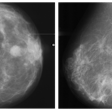CHICAGO -- MRI scans have revealed that eating ultraprocessed foods is associated with higher amounts of fat stored inside thigh muscles, according to a study presented December 4 at RSNA.
The finding remained significant in participants regardless of their total daily caloric intake, physical activity, or body mass index, and suggests that diets high in ultraprocessed foods could increase the risk for knee osteoarthritis, noted presenter Zehra Akkaya, MD, a postdoctoral researcher at the University of California, San Francisco.
“Quality of nutrition may impact muscle quality and represents a potential target for noninvasive or preventive therapeutic approaches,” she said in a statement released by the RSNA.
Previous research has shown that quantitative and functional decline in thigh muscles is associated with the onset and progression of knee osteoarthritis, Akkaya explained. On MRI images, this decline can be seen as fatty degeneration of the muscle, where streaks of fat replace muscle fibers.
While lifestyle factors have been shown to impact muscle quality, little is known about the influence of low-quality nutrition, specifically ultraprocessed foods (UPF), she noted.
To explore these associations, Akkaya and colleagues enrolled 666 subjects who previously participated in the Osteoarthritis Initiative, a nationwide research study on the prevention and treatment of knee osteoarthritis. On average, participants were 60 years old and overweight, with a body mass index (BMI) of 27. Approximately 40% of the foods that they ate in the past year were ultraprocessed.
Intramuscular fat was assessed using semi-quantitative 5-level Goutallier grades (GG), ranging between 0 (no fatty streaks in the muscle) to 4 (> 50% fatty signal), on axial T1W images. Linear regression models were used to assess the relationship between GG and annual percentages of dietary UPF.
 Axial T1-weighted bilateral thigh MR images and magnified frames providing a closer look at the areas in lateral aspects of quadriceps femoris muscles (knee extensors) from two obese, female participants, aged 58 (A) and 62 years (B), respectively. In A, the thigh muscles on both sides demonstrate abundant fatty streaks, consistent with a high Goutallier grade for this participant, whose diet from the past 12 months consisted of 68% ultraprocessed foods. In B, the thigh muscles show fewer fatty streaks as highlighted in the magnified image, consistent with a low Goutallier grade for this participant, whose diet contained only 36% ultraprocessed foods. Image courtesy of RSNA.
Axial T1-weighted bilateral thigh MR images and magnified frames providing a closer look at the areas in lateral aspects of quadriceps femoris muscles (knee extensors) from two obese, female participants, aged 58 (A) and 62 years (B), respectively. In A, the thigh muscles on both sides demonstrate abundant fatty streaks, consistent with a high Goutallier grade for this participant, whose diet from the past 12 months consisted of 68% ultraprocessed foods. In B, the thigh muscles show fewer fatty streaks as highlighted in the magnified image, consistent with a low Goutallier grade for this participant, whose diet contained only 36% ultraprocessed foods. Image courtesy of RSNA.
According to the analysis, the highest GG scores were noted for extensor muscles and the lowest GG scores for flexor muscles. The relationship between UPF and GG scores was significant across all muscles (p = 0.021), with an increase of GG by almost 1 grade for each standard deviation increase of UPF in annual diets.
“In an adult population at risk for but without knee or hip osteoarthritis, consuming ultraprocessed foods is linked to increased fat within the thigh muscles. These findings held true regardless of dietary energy content, BMI, sociodemographic factors, or physical activity levels,” Akkaya said.
Ultimately, osteoarthritis is an increasingly prevalent and costly global health issue and is highly linked to obesity and unhealthy lifestyle choices. Thus, there are potential avenues for lifestyle modification and disease management, Akkaya noted.
“Understanding this relationship could have important clinical implications, as it offers a new perspective on how diet quality affects musculoskeletal health,” Akkaya concluded.
For full 2024 RSNA coverage, visit our RADCast.



















